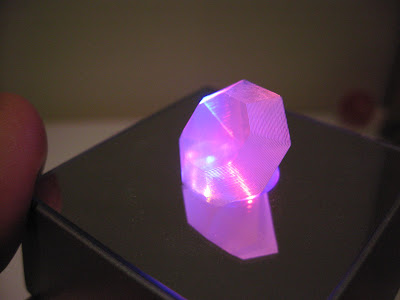The SD300 builds each model atop a re-usable magnetic pad, which clings to the build platform. Each model starts by 'gluing' a foundation layer of PVC to the magnetic pad; plastic residues eventually accumulate until the magnet has to be replaced. Luckily it's really inexpensive.
Solido encourages regular cleaning of the magnetic pad with "an alcohol based cleaner." I had initially tried isopropyl rubbing alcohol. At 91% strength the alcohol evaporated too quickly to be useful, but at 71% strength it was only modestly effective. I tried cleaning with some grain alcohol I'd bought to remove wax from some work clothes and discovered it worked much better than isopropyl. Ethyl rubbing alcohol worked better still!

Each build leaves a bit of residue on the magnet, as shown here. This magnet has been used over two dozen times, but this tiny bit of residue is from
only the last build because I've been cleaning it after every build.

It's effortless to clean the magnet after every build because I keep it in a mist-spray bottle. One disadvantage of
Ethyl Rubbing Alcohol is an offensive odor imparted by the USP-mandated traces of acetone and ketone, presumably to prevent anyone from drinking it. (Blech!) But these additives might account for its excellent solvency.

After spraying with alcohol I clean the magnet with a microfiber cloth, which seems to be more-effective than paper towels. The whole cleaning job takes less than 20 seconds because I keep the cleaner and cloth handy, and it's a worthwhile habit.

Here are four used build magnets, showing how the surface of each one held up better as I learned better cleaning habits. The oldest one, at left, has white areas where models stuck so badly they started to pull the surface apart. Each magnet lasted longer than the last, but eventually they need to be replaced because the surface eventually loses its nonstick 'release' capability even if it's kept clean.


















